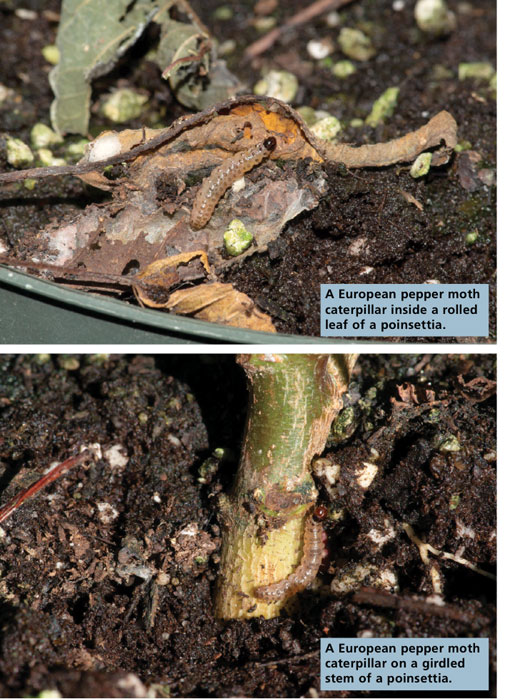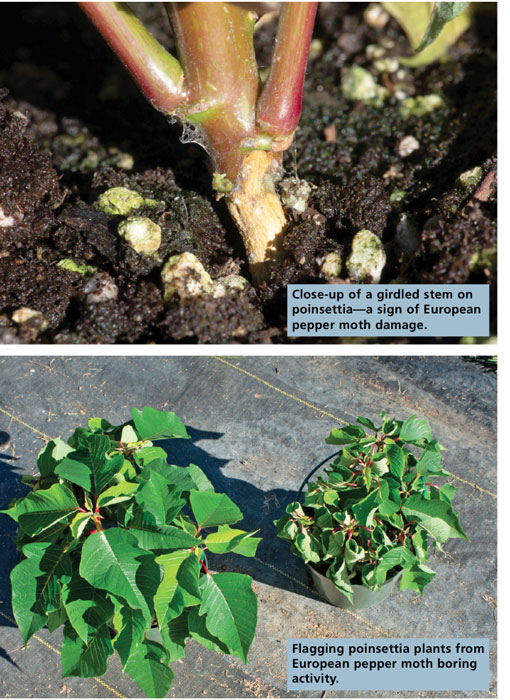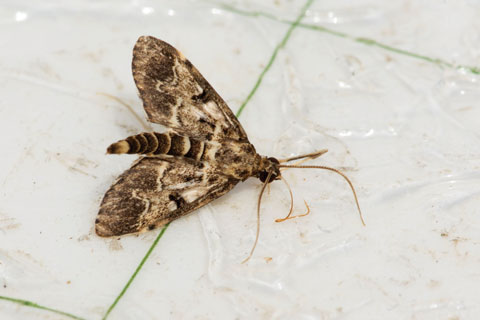12/1/2021
European Pepper Moth Expands to Nurseries & Greenhouses
Stanton Gill

The European pepper moth (Duponchelia fovealis) is a relatively new invasive species and was confirmed in a Maryland greenhouse operation in 2013. In 2021, professional IPM scouts are finding this caterpillar active in greenhouses and herbaceous perennial nurseries. North Carolina Extension agents are finding European pepper moth in several greenhouse and nursery operations in North Carolina.
Once this moth is established at an operation, it tends to re-infest even with regular treatment being made by growers. We originally said in the November 2013 issue of GrowerTalks that this pest doesn’t overwinter in Maryland, but it appears it may be adapting to micro-environments and actually overwintering in nursery and greenhouse operations.
This pest has been reported in greenhouses in southern and central California and Florida as a regular pest. Greenhouse managers and extension people working with greenhouse growers should be alert and monitor for this caterpillar pest. How much economic damage the European pepper moth might cause in the United States is still unknown, but we do know that this pest is being detected in many states in greenhouse operations.
When the adults are seen during the day they tend to fly erratically in zig zag patterns and rapidly dive into the plant canopy. The adult moths generally fly at night and can travel a fair distance during this night travel.
Since this pest has rapidly spread across the United States and Canada, traditional containment through quarantine has been discarded as impractical. In 2011, extensive monitoring was conducted in several counties in Georgia and Florida. The European pepper moth has been found infesting lantana plants in a greenhouse in Georgia. While the European pepper moth was found in greenhouses in those states, it hasn’t been found in field production of fruit or vegetables.
It might be the insect is adapted to the close growing conditions in a greenhouse environment and not suited for most field production facilities. In a greenhouse environment, the foliage touching the substrate surface may make ideal conditions for this moisture-loving pest.
The European pepper moth also has been recorded as a problem in greenhouse-grown chrysanthemums and other cut flower species in Ontario.
The moth is native to both freshwater and saltwater marshlands of southern Europe (mainland Spain, parts of France and Portugal), the eastern Mediterranean region (Greece, Italy, Corsica, Macedonia, the original area that was part of the former Yugoslavia, Malta, Crete, Sardinia and Sicily), the Canary Islands, Syria and Algeria. The larvae of this moth have been recorded on more than 70 host species in a wide range of plant families.
In the United States, the moth was first detected on begonias in San Diego County, California, in 2004. This population was eradicated. In 2010, it showed up again in San Diego county. By September of 2011, it had been detected in 17 counties in California. It’s also been detected in Alabama, Arizona, Colorado, Florida, Georgia, Kentucky, Mississippi, New York, New Jersey, North Carolina, Oklahoma, Oregon, South Carolina, Tennessee, Texas and Washington. I want to emphasize that it’s not known whether this pest is mainly a greenhouse and nursery problem only, or whether it could cause damage in field plantings.
In June of 2013, European pepper moth larvae were found infesting zonal geranium, petunia and echinacea plants in Central Maryland in a commercial greenhouse. Two alert greenhouse managers picked the caterpillars boring in the base stems of the plants and submitted samples to the Central Maryland Research & Education Center.
We identified the caterpillars with help from entomologists at the University of Florida and USDA-ARS. An MDA taxonomist, Gaye Williams, has subsequently confirmed our identification of this pest back in 2013. We worked with the growers in 2013 and 2014 to bring this infestation under control. Now, in 2021, we’re seeing herbaceous perennial growers and greenhouse growers reporting activity of the European pepper moth. And we’re seeing an increase in activity, possibly due to the unusual weather pattern of 2021.
If you work with greenhouse growers who produce ornamental and vegetable crops in greenhouses, you should alert them to be on the lookout for the European pepper moth. If they find a caterpillar that looks like the one in this article, then send a sample to your extension entomologist for identification immediately.

Plants that host for European Pepper Moth
1. Poinsettia
2. Mums
3. Recently, European pepper moth was found damaging the following herbaceous perennials: Bergenia Winterglut, Heuchera Palace Purple, Chrysogonum virginianum Pierre, Chelone glabra, Penstemon Husker Red, Heuchera Plum Pudding, Heuchera Autumn Bride, Waldsteinia ternata, Geranium Bevan’s Variety, Anemone sylvestris, Carex Bunny Blue Hobb, Carex Bunny Blue, Kalimeris Blue Star, Alchemilla erythropoda, Kalimeris Daisy Mae, Veronica Royal Candles, Geum triflorum, Ratibida Red Midget, Oenothera fruticosa, Penstemon digitalis, Polemonium reptans and Astilbe Vision in Pink (and multiple other Astilbe spp.).
What damage is inflicted by the larvae?
The eggs are laid on foliage and hatching larvae of European pepper moth initially feed on lower leaves near the soil level, making round- or crescent-shaped holes. This damage can be visually monitored in an IPM scouting program. Older larvae consume whole leaves or they can feed on roots or at the base of the plant at the soil level.
In some cases, they girdle the base of a plant. With some vegetables and fruit, the larvae bores into the fruit. Later instar larvae burrow into soft woody or herbaceous stems, causing a boring damage in which fungi can make entry. In the zonal geranium brought into our lab, the stems had visible holes and this is what workers first detected. As the larvae prepare to pupate, they web silk together, usually on foliage close to the soil.
Life cycle
The moth is active at night and lays white eggs in small clusters on the undersides of foliage, usually close to a main vein. Eggs have been recorded on stems and on the tops of leaves, but usually are found on undersides of foliage. The egg clusters are in groups of three to 10, usually laid in overlapping patterns. The eggs turn pink, then red as the embryo develops and end up brown colored just before hatching.
The larvae have a dark-colored head capsule and a dark-colored hardened dorsal plate just behind the head. On segments just behind the head, there are two rows of transverse spots. There’s at least one stout hair sticking out of each spot.
The larvae feed mainly at night and avoid light. When we placed live larvae under a dissecting microscope with a light source, they were actively trying to move out of the lit area. As the larva grow their body color changes from a creamy white to a dirty brown color. The larvae lose their spots just before pupation.
The length of development depends on temperature, but in a greenhouse at 68F (20C) the egg stage is four to nine days, the larval stage is three to four weeks, one to two weeks for pupation and adults for one to two weeks. Females mate soon after emerging. The males and females are strong fliers and have been recorded to fly several miles.
Controlling an infestation
Cultural control removing debris and lower leaves will reduce habitat for the larvae. The problem with this is that most plants grown in greenhouses are grown to have leaves all of the way to the soil level. If this moth becomes established in the greenhouse, then making the effort to remove lower foliage will help reduce larval populations. Many growers are reporting that it’s very difficult to make contact with the larvae unless lower foliage is removed. Using contact material may be very limited in efficacy because the lower foliage protects the larvae from insecticide contact. Systemic insecticides may be necessary in many cases.
Chemical control
Fortunately, this caterpillar is susceptible to several classes of pesticides. Young larvae feeding on foliage are fairly easy to hit with pesticides. Older larvae, which bore into stems or fruit, are less accessible to insecticides and therefore are more difficult to control. Bacillus thuringiensis with repeated sprays can be directed on the foliage to kill larvae feeding on the foliage. Spinosad materials should also be effective in controlling the caterpillars.
Acephate in preliminary trials has been shown to be one of the more effective materials for control. Mainspring and Acelepryn from Syngenta appears to give control for four to six weeks.

How can you monitor?
There are pheromone baits and traps for European pepper moth available from Koppert, Syngenta and Biobest. A baited delta-shaped or funnel trap works in capturing males. Both trap designs have worked for us in monitoring. This should be combined with scouting the susceptible plants for feeding of larvae. Again, this pest was found in a greenhouse and nursery environment.
Pictured: An adult European pepper moth caught from an insect trap.
Discard infested plants. In working with greenhouse operations, we found that many growers throw infested plants into a discard pile somewhere on the greenhouse grounds. If you do this make sure you turn the discarded plants weekly so the outer plants are turned inward and the pile truly composts, reaching 140 to 160F (60 to 71C) in the center of the pile. This will kill any larvae in the discarded plants. If you don’t do this, the larvae will pupate and adults will re-infest your growing area.
If you find larvae or adults in a greenhouse, please contact me at Sgill@umd.edu. GT
Stanton Gill is an Extension Specialist in IPM for Greenhouses and Nurseries at the University of Maryland Extension, and Professor at Montgomery College in the Landscape Technology Program.